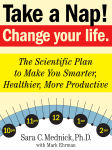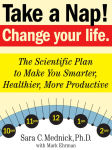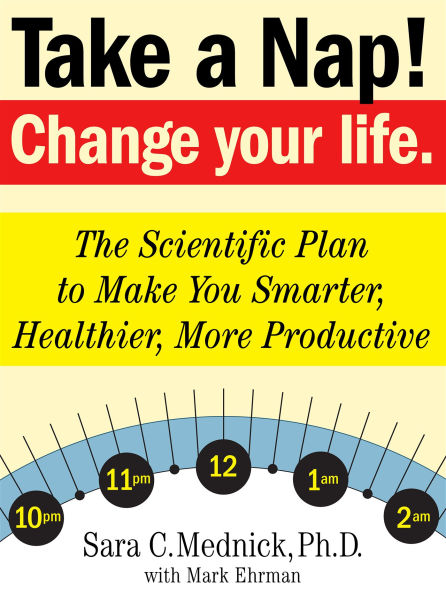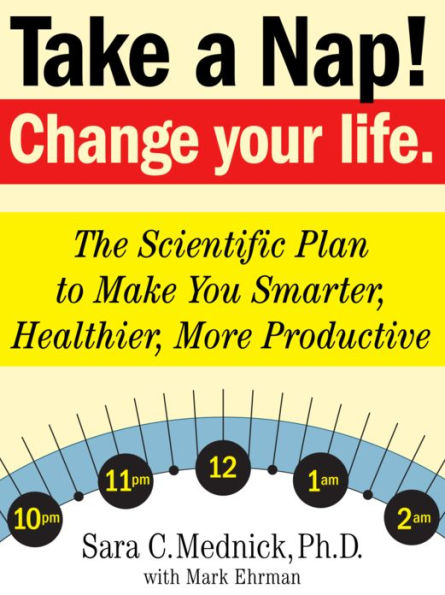Read an Excerpt
CHAPTER 1
The new nap:not your grandfather's siesta
Imagine yourself in a perfect world. Your mood is positive. Your brain is operating at maximum efficiency. Your body feels healthy, energetic and agile. You have enough time to complete all the tasks at hand and still enjoy the company of family and friends. Every one of your goals is attainable.
In this wonderful land of your imagination, you enjoy a well-balanced diet, get enough exercise, breathe clean air and spend quality time with friends and family. What you aren't doing is walking around tired, right?
So ask yourself, "If I inhabited such a place, how much would I sleep?" Stumped? You're not alone. Most people don't get further than "a whole lot more than I'm sleeping now." After all, how do you remove the pressures of bills, job and relationships to create an oasis where you can even begin to envision what such a perfect world would involve?
Lucky for you, scientists have already resolved this issue. Our results back up what historians, anthropologists, artists and numerous brilliant leaders and thinkers have been telling their contemporaries throughout the ages. In a perfect world, all humans, including you, would nap.
It is written ... in our DNA
Let's look at the rest of the animal kingdom. Do any other species try to get all their sleep in one long stretch? No. They're all multiphasic, meaning that they have many phases of sleep. Homo sapiens (our modern industrialized variety, anyway) stand alone in attempting to satisfy the need for sleep in one phase. And even that distinction is a relatively recent development. For most of our history, a rest during the day was considered as necessary a component of human existence as sleeping at night. As A. Roger Ekirch, one of the few historians to study sleep, put it, "Napping is a tool as old as time itself."
Does this mean that cave people napped? Well, little is known about sleep/wake habits back in the Stone Age, but the best guess is that sleep occurred throughout the day and night. Looking at contemporary primitive cultures, we find that the Gebusi of Papua New Guinea engage in multiphasic sleep. It makes sense that primitive peoples would sleep in short periods, since someone always has to keep watch for predators, but most of us no longer have to lose sleep over lions and tigers. With the advent of civilization, our sleep consolidated into fewer episodes, and eventually we fell into what scientists have come to realize is our fundamental, internally programmed pattern: biphasic sleep composed of one long period during the night and a short period in the middle of the day.
By the first century B.C., the Romans had divided their day into periods designated for specific activities, such as prayer, meals and rest. Midday became known as sexta, as in the sixth hour (noon by their way of counting), a time when everyone would go to bed. The word has survived in the familiar term siesta.
But hard scientific evidence that the nap is woven into our DNA didn't arrive until the modern era, when Dr. Jurgen Aschoff of the Max Planck Institute in Germany carried out a study that can only be described as peculiar. In the 1950s, Dr. Aschoff refurbished some abandoned World War II bunkers with all the amenities of small one-bedroom flats, except that they had no windows, clocks, televisions, radios or newspapers — no way to tell the date or time or even whether it was day or night. He then paid volunteers to live in them for a period of weeks, during which time he monitored their temperature, blood pressure and various other biological indicators. After a short transitional phase, subjects generally experienced one large dip in energy in the middle of the "night," when they would sleep six to seven hours; roughly 12 hours later, a mini-dip would drive them back to bed for a shorter period of sleep.
In other words, when people are forced to follow their own internal imperatives, the nap quickly reasserts its rightful place in the behavioral scheme. Subsequent studies proved this to be the case even among people who believed themselves incapable of napping, as well as in circumstances where they were specifically instructed not to nap!
The unseen hand guiding sleep and waking is our so-called biological clock or circadian (circa = around, dia = day) rhythm. This fundamental property of the human circuitry regulates sleep as well as body temperature, heart rate, growth hormone and urine production. But it doesn't just govern human biology. All living things — from a single blood cell to a two-ton elephant — dance to the beat tapped out by their circadian drum.
While Dr. Aschoff arrived at his discovery by accident, like a Christopher Columbus of human biology, University of Pennsylvania professor Dr. David Dinges was the first scientist to pose the direct question "Is napping natural?" In 1989 he brought together an impressive collection of sleep experts to examine napping across life span, occupation, culture and even species. A consensus emerged that not only is napping beneficial for alertness, mental ability and overall health, but our brains are actually programmed for it. "In examining sleep's orphan," Dr. Dinges concluded, "we found a lost progeny."
The siesta is dead. Long live the nap!
So how did we lose this progeny? We can start by blaming the clock. Between the 13th and 15th centuries, mechanical timepieces replaced the sundial and water clock. The day, having previously been regarded as a series of experiences, could now be reduced to the passage of measurable units: seconds, minutes and hours. Workers began getting paid by the hour instead of by the job, and it didn't take long for the "Time is money" mantra to become the de facto law of the land. Sleep, especially during the day, began to be perceived as a waste of both. Interestingly, our English word nap traces back to the Old English word hnappian, "to doze," which first appeared in the 14th century.
As the Industrial Revolution progressed, biphasic sleep began to disappear from the more developed countries of northern Europe, particularly in the newly expanding cities. These cities were bursting with commerce, factories and culture, expanding the workload on individuals so that people were working longer hours and, unfortunately, at a younger age. The siesta survived in the less-developed south, because the intense heat of midday drove every-one — bosses and workers — to their beds. But eventually the march of progress reached the Mediterranean countries, and the siesta waned as they air-conditioned their environments and joined the competitive global economy. Today, only 7 percent of Spaniards living in big cities sleep during the day.
What's needed now is a program that will reclaim the nap without resurrecting the siesta, and here's where science must take the lead. Examining the habits of primitive tribesmen and ancient Romans won't help you create the time and place where you can restore your body to its natural rhythm if you're holding down two jobs and trying to raise a family. And while it's inspiring to know that Leonardo da Vinci, Isaac Newton, Napoleon Bonaparte and Albert Einstein refused to succumb to the madness of monophasic sleep, citing their example probably won't convince your boss that napping at work will be good for your company's bottom line. You can talk until you're blue in the face about the many U.S. presidents, including John F. Kennedy, who believed in napping. You can cite the example of Winston Churchill, who credited the nap with winning the Battle of Britain: "We were not made by Nature to work, or even to play, from eight o'clock in the morning till midnight," he famously said. "We ought to break our days and our marches into two." But none of these points will stem the anti-nap tide.
Scientists no longer argue about whether napping is natural or unnatural, helpful or unhelpful. These are givens. We now explore more technical questions, such as how duration, timing and quality affect the benefits derived from a nap and how people outside the experimental setting can reap those benefits on an everyday basis. What we are doing is much more than simply identifying a human behavioral trait. We are creating a new wellness technology.
Think of the Internet. Before people with vision realized the potential of the World Wide Web, this network was a little-known tool used primarily by specialized populations such as academia and the Department of Defense. So, too, are emergent nap "technologies" poised to move from specialized subgroups to the population at large. NASA, for instance, devised a precise schedule of in-flight naps that improved performance of pilots on extended flights. Numerous airlines and railroads, including British Airways, Air New Zealand and Amtrak, have adopted the program. Why shouldn't these powerful tools be available to you?
In 2002–03, my colleagues at Harvard and I conducted a series of studies looking at naps in normal populations. We proved not only that a nap can restore proficiency in a variety of critical skills that we rely upon every day, but also that certain kinds of naps can produce improvements previously observed only after a full night of sleep. Even more groundbreaking was the discovery that we can combine the specific stages of sleep to target areas of improvement more precisely. In other words, we can create "designer naps" that allow students, mothers, the elderly and nine-to-fivers to tailor their own regimens to suit their individual needs. Using our knowledge of sleep's effects on the brain and body, naps can now be integrated into our lives in a more targeted, efficient manner.
As a result, we have entered a new napping age. We now know that it's not necessary to shutter an entire city during a regular siesta time to keep people healthy, alert and well rested. We also know that, with the help of science and a little attitude change on your part, you are now in position to bring a bit of that perfect world into your life today.
And not a moment too soon.
CHAPTER 2
Fatigue:a hidden epidemic
Just after midnight on March 24, 1989, the Exxon Valdez, a floating behemoth laden with 53 million gallons of crude oil, was sailing the dark, icy waters off the southern coast of Alaska. The ship's captain, Joe Hazelwood, had drunk more than his share of vodka and had retired to his cabin ...
Filling in for the captain, Third Mate Gregory T. Cousins knew they were approaching Bligh Reef but failed to notice that the tanker was on autopilot and thus not responding to his call for a change in course. As a result, the reef sliced through the hull, spilling a fifth of the toxic cargo into Prince William Sound, wiping out 250,000 seabirds, 2,800 sea otters, 300 harbor seals, 250 bald eagles, 22 killer whales and billions of salmon and herring ... and fouling 1,300 miles of heretofore pristine coastline.
What does a 10-million-gallon oil slick have to do with a nap? The National Transportation Safety Board investigation attributed the accident to the fact that Cousins, who had been awake for 18 hours prior to taking the helm of the Valdez, failed to "properly maneuver the vessel because of fatigue and excessive workload." Given what science can tell us about the deleterious effects of sleep deprivation on decision-making, alertness and coordination, a case can be made that had Cousins simply lain down for a brief sleep, one of the greatest environmental catastrophes in recent memory — and the $2.5 billion cost for cleanup — might have been averted.
While the fate of the Exxon Valdez represents perhaps the most dramatic reason for reintroducing the nap into our culture, it is far from the only one. The pace of life has accelerated to the point where all of us must ask if there is a Valdez waiting to happen in our lives.
The walking tired
Imagine a silent epidemic wreaking havoc on our health, endangering our safety and straining our relationships with family and loved ones. The body count rises dramatically, yet no presidential task forces are assembled, no big celebrity fund-raisers are held and very little outcry is heard in the media. As a result, millions of afflicted people go on as if nothing is amiss and the spread of the disease continues unabated. This is no imaginary scenario. The plague is upon us. It's called fatigue.
For decades, with hardly anybody noticing, one of our most precious natural resources has been ebbing away. Sleep. What might be called the recommended daily allowance is eight hours, but who among us gets nearly that much? According to the latest statistics by the National Sleep Foundation, almost 50 million Americans suffer from sleep deprivation.
Working late has become the new norm. On average, Americans spend 46 hours per week at their place of employment, and 38 percent work more than 50 hours, while in Canada the National Work-Life Conflict Study of the Canadian Safety Council has found that hours on the job are increasing there, too. Only in South Korea are work hours longer than ours. According to a recent report in the Chicago Tribune (September 2005), 7.6 million of us hold two jobs simply to make ends meet. And we're commuting longer hours to get to those jobs. Something has to give. And most often, we choose what we erroneously believe to be the most expendable commodity: sleep.
Before Thomas Edison's lightbulb, our great-grandparents would get as much as 10 hours' rest during an average weeknight. Today, we're lucky to get eight hours on the weekend. The amount of actual weeknight slumber has shrunk, on average, to an alarming 6.7 hours. We are a nation of the walking tired, so much so that 51 percent of the workforce reports that sleepiness on the job interferes with the volume of work they can do. One in five adults is so sleepy that it interferes with his or her daily activities a few days a week, while an additional 20 percent report impairment a few days a month.
Once the nation with the most productive workforce in the world, the United States, by a number of measures, has fallen behind countries such as France and Germany. Our standard of living is slipping. Our students are underperforming. Our collective health is deteriorating. In areas such as science and technology, we no longer dominate. Politicians, pundits and experts from all fields have made an industry out of explaining what's going wrong. But continually overlooked is the role of that quiet little demon: fatigue.
Asleep on the job: a threat to safety
A sleep-deprived population is a dangerous population. And no one, not even the most rested of us, is safe. While the Exxon Valdez may be the most egregious example of the dangerous ramifications of sleeplessness, fatigue has been cited as at least a contributing factor in many of the worst disasters in recent history — the Union Carbide chemical explosion that killed thousands of people in Bhopal, India, and the nuclear catastrophe at Chernobyl, to name just two.
Here's why: No single organ is affected by lack of sleep more than the brain. In order to function, it must metabolize the glucose that it receives via the circulation of blood. Neither process is possible without sleep. Positron-emission tomography (PET) and functional magnetic resonance imaging (fMRI) scans, specialized imaging technologies that show changes in brain metabolism related to mental processing, performed on sleep-deprived subjects reveal that blood flow is most compromised to the thalamus, pre-frontal cortex and inferior parietal lobe. These three components of the brain play critical roles in decision-making, attention span and the speed at which we adapt to new information.
At the front
Even the most intensive physical training offers no exemption from the cruel calculus of sleep deprivation. Studies commissioned by the Department of Defense and the Defense Advanced Research Projects Agency found that lack of sleep degrades not only the ability of combat soldiers to identify and locate the enemy, but also — and even more disturbingly — their capacity to care whether they succeed or not. Think of how this bears on the escalating incidents of friendly fire. In World War II, for instance, 21 percent of U.S. casualties were the result of actions by Allied forces. In Vietnam, the figure rose to 39 percent. In the Gulf War, 45 percent of American casualties were attributed to friendly fire. And in the first week of the war in Iraq, that number rocketed to a staggering 66 percent. As retired Special Forces Major F. Andy Messing Jr., executive director of the National Defense Council Foundation, put it at the time, "The biggest killer is fatigue, and right now we have a whole army running toward Baghdad on zippo hours of sleep."
The military's solution is to dose our fighting men and women with stimulants to keep them going and "alert." The problem with this approach became abundantly clear in January 2003, when Air Force majors William Umbach and Harry Schmidt faced court-martial after a friendly fire incident over Kandahar, Afghanistan, that killed four Canadian soldiers and wounded eight others. Umbach's counsel publicly revealed what had previously only been whispered in the halls of the Pentagon — that the pilots' judgment was impaired because superiors pressured them to take "go pills" containing the powerful amphetamine Dexedrine and, moreover, that the practice was widespread.
(Continues…)
Excerpted from "Take a Nap! Change your life."
by .
Copyright © 2006 Sara C. Mednick and Mark Ehrman.
Excerpted by permission of Workman Publishing.
All rights reserved. No part of this excerpt may be reproduced or reprinted without permission in writing from the publisher.
Excerpts are provided by Dial-A-Book Inc. solely for the personal use of visitors to this web site.






